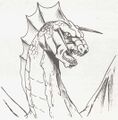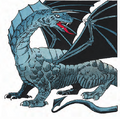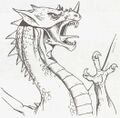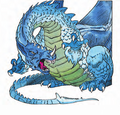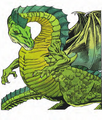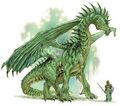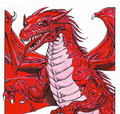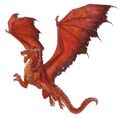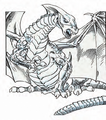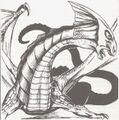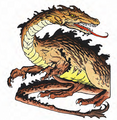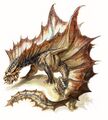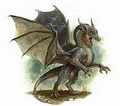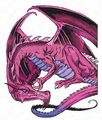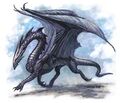Chromatic Dragon: Difference between revisions
1d4chan>Tzer (→Orange dragon: dragon compendium vol 1) |
|||
| Line 64: | Line 64: | ||
===White Dragon=== | ===White Dragon=== | ||
Smallest and weakest of their kind, White Dragons are feral and savage, notably inferior in intelligence to the other Chromatic breeds (that doesn't mean they are stupid though, they just don't like to use their brains that much). Their icy breath weapon is nothing to sneeze at, though. They even use it to encase their hoard and trophies in ice so that they can decorate their lair. It also makes it pretty difficult for potential thieves to come and grab something, as they first have to break the ice to get to the stuff, at risk of having the dragon return and add the said thieves to its frozen collection. Crystal dragons are known to take their eggs and raise them to make them less evil this may result in a white dragon that uses its brain more and defies the stereotype. | Smallest and weakest of their kind, White Dragons are feral and savage, notably inferior in intelligence to the other Chromatic breeds (that doesn't mean they are stupid though, they just don't like to use their brains that much). Their icy breath weapon is nothing to sneeze at, though. They even use it to encase their hoard and trophies in ice so that they can decorate their lair. It also makes it pretty difficult for potential thieves to come and grab something, as they first have to break the ice to get to the stuff, at risk of having the dragon return and add the said thieves to its frozen collection. Crystal dragons are known to take their eggs and raise them to make them less evil; this may result in a white dragon that uses its brain more and defies the stereotype. | ||
<gallery> | <gallery> | ||
White dragon MM 1e.png | White dragon MM 1e.png | ||
Revision as of 04:13, 29 June 2021
Chromatic Dragons are one of the many specific breeds of dragon native to Dungeons & Dragons and Pathfinder. They are one of the two most iconic family groupings of D&D dragons, alongside the Metallic Dragons. Lesser D&D dragon families have include the Catastrophic Dragons, Ferrous Dragons, Gem Dragons, Oriental Dragons (or "Imperial Dragons", for Pathfinder) Planar Dragons, and Epic Dragons.
In an expansion of the alignment mechanic, chromatics helped define what our frenemies on TVTropes calls "Color Coded For Your Convenience", where the general color-scheme of a dragon immediately helps you figure out what they are as a general rule.
Chromatic Dragons are always based on "plain" colors, and are usually portrayed as Evil aligned in various different ways depending on the precise breed. Their associated patron goddess is Tiamat, who materializes as a gargantuan she-dragon with five heads, corresponding to the five most iconic breeds of Chromatic Dragon.
They uniquely unlike metallics are more likely to breed between species(of chromatics) and create mules as shown in dragon magazine #65 and #248 which have mixtures between the breathtypes when its chromatics. and a light mention in 3e draconomicon as crossbreeds. And.. dragons can crossbreed with pretty much anything heck there was a bear dragon in an ashardalon campaign. Now i know your wondering does this mean dragons can crossbreed with other dragon types(i.e chromatic+metallic) The answer is yes but the child is usually viewed as an abbaration and hunted down.But it is possible for a dragon to care for it but thats extremely rare each dragon is unique after all.
Chromatic dragons can learn polymorph if they work for it unlike the metallics who get it naturally or any spell really heck even dragons have their own spells they can learn.
The Original 5
Black Dragon
Black Dragons favor swampy lairs where they can lie in ambush crocodile-style, since they can breath underwater. They are also known as "skull dragons" for their skeletal facial features. They tend to be described as particularly cruel and sadistic, even by dragon standards. They wield gouts of acid slime as a breath weapon.
Blue Dragon
Blue Dragons are iconic for their single enormous snout-tip horn, like a rhino's. Using powerful blasts of lightning breath to vaporize foes, they are traditionally considered denizens of the desert - which many fans find a little weird, given they are, y'know, bright freaking blue. They have the ability to flat out destroy water. Unusually this ability is exclusive to them, yet the ability to create indefinitely lasting water from nothing is everywhere. 4th edition made them prefer coastal regions and other places where storms are common, instead. They are traditionally portrayed as amongst the most reasonable and least malevolent of the Chromatics; show them respect, and they'll usually leave you alone. In 5th edition, they're back to living in deserts and dry steppes.
Green Dragon
Favoring forest environments, Green Dragons are characterized as manipulators and head-gamers par excellence. These dragons had it kind of rough in 3rd edition; with the change to poison rules in that edition, their traditional breath weapon, a gout of poisonous vapor, no longer worked, so they were forced to use corrosive fumes and do acid damage instead. They went back to poison after 3rd edition.
In Pathfinder they're actually decently likely (possibly 1 in 10, but likely lower) to be neutrally aligned. This is largely a result of them being too lost in their books to care about being evil.
Red Dragon
The most iconic and traditional of all D&D dragons, Red Dragons are arrogant, greedy, hot-tempered, flame-spewing, power-hungry, malevolent brutes who enjoy eating maidens.
White Dragon
Smallest and weakest of their kind, White Dragons are feral and savage, notably inferior in intelligence to the other Chromatic breeds (that doesn't mean they are stupid though, they just don't like to use their brains that much). Their icy breath weapon is nothing to sneeze at, though. They even use it to encase their hoard and trophies in ice so that they can decorate their lair. It also makes it pretty difficult for potential thieves to come and grab something, as they first have to break the ice to get to the stuff, at risk of having the dragon return and add the said thieves to its frozen collection. Crystal dragons are known to take their eggs and raise them to make them less evil; this may result in a white dragon that uses its brain more and defies the stereotype.
Other Chromatic Dragons
Brown Dragon
Introduced in the Forgotten Realms in AD&D, Brown Dragons are desert-dwelling burrowers who have changed markedly over the editions. Rising to prominence in 4e as part of the Chromatic Draconomicon, they were given back limited flight (traditionally not available to them) and were given the strange trait of being gourmet epicures; they love food and prize unique flavors and cooking skills. Brown Dragons use high-velocity gouts of sand to scour flesh from bone.
Gray Dragon
Gray Dragons didn't exist until 4th edition adapted them from the minor "outcast" dragons of Faerun known as Fang Dragons, giving them caustic, petrifying slime as a breath weapon, petrifying claw and bite attacks, and an obsession with hunting. Prior to that, the only claimant to the name "Gray Dragon" was a breed of linnorm.
Purple Dragon
Like Brown Dragons, Purple Dragons were adapted from a Forgotten Realms dragon of AD&D, the Deep Dragon. These slender, serpentine Chromatics are the primary draconic denizens of the Underdark, using their psychotropic venom breath and power to turn into insubstantial shadows to sate their wanderlust by roaming the ever-changing depths of the world. The most epic purple dragon was the simply named "Dragon", in the first Heroes of Might and Magic vidya (there actually are two different purple dragons one is the deep dragon and another in the dragon magazine 65 248 which had energy breath and was a crossbreed between red and blue and was really really strong)
Yellow Dragon
Yellow Dragons haven't been seen since 2nd edition(well besides the dragon magazine 248). Like blue dragons, they prefer deserts and have the ability to destroy water. Their favorite method of capturing prey is to dig a pit in the sand and bury themselves in the center, acting like a giant antlion. Their breath weapon is a blast of scorching hot air mixed with sand.
Orange dragon
First revealed in dragon magazine 65 and expanded in 248 updated to 3.5 in dragon compendium vol 1 along with yellow and the original hybrid/energy using purple dragon Their breath is that of liquid sodium with an oil covering which can explode when in contact with water and they are really sadistic They really love lairing in waters not just swamps if you want a lake dragon that is a normal one heres your guy. their natural enemies are bronze dragons.
| The Dragons of Dungeons & Dragons | |
|---|---|
| Dragons | Albino Wyrm - Arcane Dragon - Aquatic Dragon - Brine Dragon - Catastrophic Dragon - Cerilian Dragon - Chromatic Dragon - Cloud Dragon - Cobra Dragon - Crimson Dragon - Deep Dragon - Dragonet - Epic Dragon - Faerie Dragon - Fang Dragon - Ferrous Dragon - Gem Dragon - Half-Dragon - Linnorm - Metallic Dragon - Minidragon - Mist Dragon - Moon Dragon - Obsidian Dragon - Oriental Dragon - Planar Dragon - Prismatic Dragon - Pseudodragon - Radiant Dragon - Red Hawk Dragon - Sand Dragon - Sea Wyrm - Shadow Dragon - Song Dragon - Stellar Dragon - Stone Dragon - Sun Dragon - Dragon Turtle |


